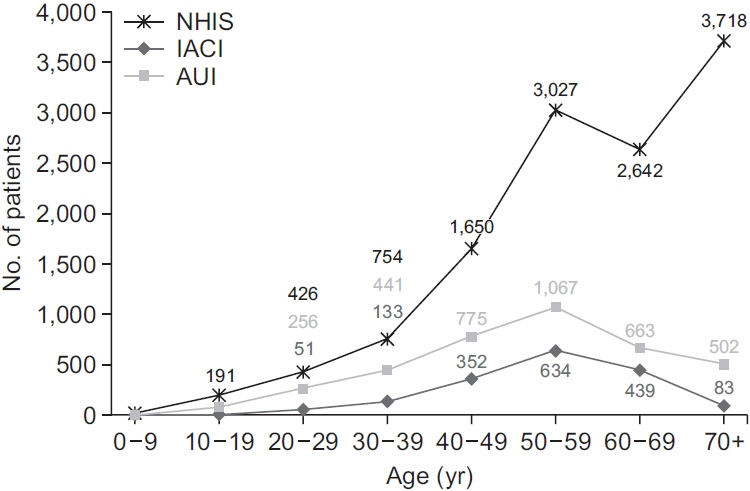Ann Rehabil Med.
2023 Feb;47(1):4-10. 10.5535/arm.23020.
Spinal Cord Injury Fact Sheet in Korea
- Affiliations
-
- 1Department of Rehabilitation Medicine, Seoul National University Hospital, Seoul, Korea
- 2National Traffic Injury Rehabilitation Research Institute, National Traffic Injury Rehabilitation Hospital, Yangpyeong, Korea
- 3Department of Physical Medicine and Rehabilitation, Dong-A University College of Medicine, Busan, Korea
- 4Department of Rehabilitation Medicine, Seoul National University College of Medicine, Seoul, Korea
- KMID: 2539722
- DOI: http://doi.org/10.5535/arm.23020
Abstract
- Spinal cord injury (SCI) has been recognized as a medically complex and life-disrupting condition. As the aging of the population accelerates, the trend of SCI has changed. This review aimed to provide comprehensive statistics and recent epidemiological changes in SCI and rehabilitation in Korea. All three insurance databases (National Health Insurance Service [NHIS], automobile insurance [AUI], and industrial accident compensation insurance [IACI]) were considered. These nationwide databases provide data on the current trends in term of incidence, etiology, and rehabilitation of SCI. Traumatic spinal cord injury (TSCI) was more frequent among the elderly in the NHIS compared to working age individuals in the AUI and IACI. In all three trauma-related insurance databases, male with TSCI outnumbered female. TSCI incidence per year was approximately 17 times higher among males than females, on average, in IACI. In all three insurances, the cervical level of TSCI was the most frequent. Although the ratio of SCI patients receiving rehabilitation treatment at primary and secondary hospitals increased for nine years, the increase in training on activities of daily living (ADL training) was found to be relatively small. This review provides a broader and comprehensive understanding of the incidence, etiology, and rehabilitation treatment of SCI in Korea.
Keyword
Figure
Cited by 2 articles
-
Trends in the Incidence and Etiology of Non-Traumatic Spinal Cord Injury in Korea: A Nationwide Population-Based Study From 2007 to 2020
Yoonjeong Choi, Ja-Ho Leigh, Jooeun Jeon, Goo Joo Lee, Hyung-Ik Shin, Moon Suk Bang
J Korean Med Sci. 2023;38(18):e158. doi: 10.3346/jkms.2023.38.e158.Risk Factors for Suicidality in Individuals With Spinal Cord Injury: A Focus on Physical and Functional Characteristics
Sora Han, Wooyeung Kim, Onyoo Kim
Ann Rehabil Med. 2023;47(5):377-384. doi: 10.5535/arm.23110.
Reference
-
1. Bickenbach J, Officer A, Shakespeare T, von Groote P. International perspectives on spinal cord injury. Geneva: World Health Organization;2013.2. Shin H. Etiology and epidemiology of spinal cord injury in Korea. J Korean Med Assoc. 2020; 63:589–95.3. National Spinal Cord Injury Statistical Center. Spinal Cord Injury Model Systems. Complete public version. Birmingham: University of Alabama at Birmingham;2013.4. Lee BS, Kim O, Ham D. Epidemiological changes in traumatic spinal cord injuries for the last 30 years (1990-2019) in South Korea. Spinal Cord. 2022; 60:612–7.5. Choi SH, Sung CH, Heo DR, Jeong SY, Kang CN. Incidence of acute spinal cord injury and associated complications of methylprednisolone therapy: a national population-based study in South Korea. Spinal Cord. 2020; 58:232–7.6. Kumar R, Lim J, Mekary RA, Rattani A, Dewan MC, Sharif SY, et al. Traumatic spinal injury: global epidemiology and worldwide volume. World Neurosurg. 2018; 113:e345–63.7. Miyakoshi N, Suda K, Kudo D, Sakai H, Nakagawa Y, Mikami Y, et al. A nationwide survey on the incidence and characteristics of traumatic spinal cord injury in Japan in 2018. Spinal Cord. 2021; 59:626–34.8. Yang NP, Deng CY, Lee YH, Lin CH, Kao CH, Chou P. The incidence and characterisation of hospitalised acute spinal trauma in Taiwan--a population-based study. Injury. 2008; 39:443–50.9. Liu P, Yao Y, Liu MY, Fan WL, Chao R, Wang ZG, et al. Spinal trauma in mainland China from 2001 to 2007: an epidemiological study based on a nationwide database. Spine (Phila Pa 1976). 2012; 37:1310–5.10. Choi Y, Kim YE, Leigh JH, Lee YS, Kim HK, Yi YG, et al. Comparison of trends in the incidence of traumatic spinal cord injury in daily life, automobile accidents, and industrial accidents: a national multi-insurance study in Korea. J Korean Med Sci. 2023; 38:e26.11. Shin JC, Kim DH, Yu SJ, Yang HE, Yoon SY. Epidemiologic change of patients with spinal cord injury. Ann Rehabil Med. 2013; 37:50–6.12. Jain NB, Ayers GD, Peterson EN, Harris MB, Morse L, O’Connor KC, et al. Traumatic spinal cord injury in the United States, 1993-2012. JAMA. 2015; 313:2236–43.13. Cripps RA, Lee BB, Wing P, Weerts E, Mackay J, Brown D. A global map for traumatic spinal cord injury epidemiology: towards a living data repository for injury prevention. Spinal Cord. 2011; 49:493–501.14. Han ZA, Lee BS, Kim W, Lee SJ, Im HJ, Kim C, et al. People with spinal cord injury in Korea. Am J Phys Med Rehabil. 2017; 96(2 Suppl 1):S83–5.15. Park CI, Shin JC, Kim SW, Jang SH, Chung WT, Kim HJ. Epidemiologic study of spinal cord injury. J Korean Acad Rehabil Med. 1999; 23:267–75.16. Lee BS, Kim O, Ham D. Epidemiologic changes in nontraumatic spinal cord injury for the last 30 years (1990-2019) in South Korea. Spinal Cord. 2022; 60:268–73.17. Arul K, Ge L, Ikpeze T, Baldwin A, Mesfin A. Traumatic spinal cord injuries in geriatric population: etiology, management, and complications. J Spine Surg. 2019; 5:38–45.18. Algahtany M, McFaull S, Chen L, Zhang S, Saarela O, Alqahtani F, et al. The changing etiology and epidemiology of traumatic spinal injury: a population-based study. World Neurosurg. 2021; 149:e116–27.19. Nas K, Yazmalar L, Şah V, Aydın A, Öneş K. Rehabilitation of spinal cord injuries. World J Orthop. 2015; 6:8–16.


